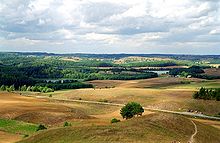
The Suwałki Lake District (Polish Pojezierze Suwalskie) is part of the Ice Age East Baltic Lake Districts and lies in the northeast Poland, on the border to Lithuania. She becomes the Lithuanian Lake District as well as the historical region Suwalszczyzna expected. The region is located in the north of the voivodeship Podlaskie. A small part is also in the far east of Warmia-Masuria. It borders on the to the west Masurian Lake District, in the northwest to the Romniter Heide and in the south to the jungle of Augustów. The Rospuda, Czarna Hańcza and Marycha have their origin in the lake district.
Regions

The Suwałki Lake District macro-region is divided into:
Western Suwałki Lake District
Eastern Suwałki Lake District
Augustów Lake District
- 6 Blizno
- 7 Serwy
- 8 Necko
- 9 White Augustów Lake
- 10 Studzieniczne
- 11 Sajno
places

The area is very sparsely populated, there are almost no cities and the landscape is natural.



Other goals
- 1 Wigry National Park

- 2 Wigry Baroque Monastery
- 3 Augustów Heath
background
From ancient times, Polish, Lithuanian, Belarusian, German, Tatar and Jewish influences mixed in the area. Nevertheless, it remained very sparsely populated. There was never any industry or large settlements here. The only economic factor in the region was the Wigry monastery.
The numerous moraine hills here reach a height of almost 300 meters above sea level. Of the over numerous large lakes are the Wigry and the Hańcza the biggest. The latter is the deepest lake in Poland at 113 meters.
language
The official and lingua franca is Polish. You can get along well with English everywhere.
getting there
The nearest international airport is 1 Olsztyn Airport![]() (IATA: SZY)but it is more than 100 km away. The journey can also be made via the expressway Białystok respectively.
(IATA: SZY)but it is more than 100 km away. The journey can also be made via the expressway Białystok respectively.
mobility
The road, rail and bus network is quite thin. A separate mobile stand is very helpful here.
Tourist Attractions
The baroque monastery on Lake Wigry is well worth seeing.
activities
The lake district is shaped by hundreds of lakes and moraine hills from the Ice Age and is ideal for water sports. Many large lakes (e.g. Hańcza Lake) are with the Augustów Canal, the Rospuda or the Czarna Hańcza connected, so that a network of many kilometers of waterways is practically open to canoeists and sailors.
kitchen
Due to the numerous lakes and rivers, fresh freshwater fish is available cheaply everywhere.
nightlife
The nightlife is concentrated in the big cities outside of the Lakeland.
security
It's pretty safe.
climate
There is a transitional climate with a continental impact. The summers are warm to hot, the winters cold.
trips
literature
You article too Poland.



.jpg/320px-Lazdijų_sen.,_Lithuania_-_panoramio_(43).jpg)
.jpg/320px-Pomorze(lake).jpg)

.jpg/320px-Jezioro_-_Blizno_-_panoramio_(3).jpg)


_02.JPG/350px-Augustów_-_Jezioro_Białe_(by_Pudelek)_02.JPG)


.jpg/220px-Jezioro_Hańcza,_2018-08-06_(01).jpg)








